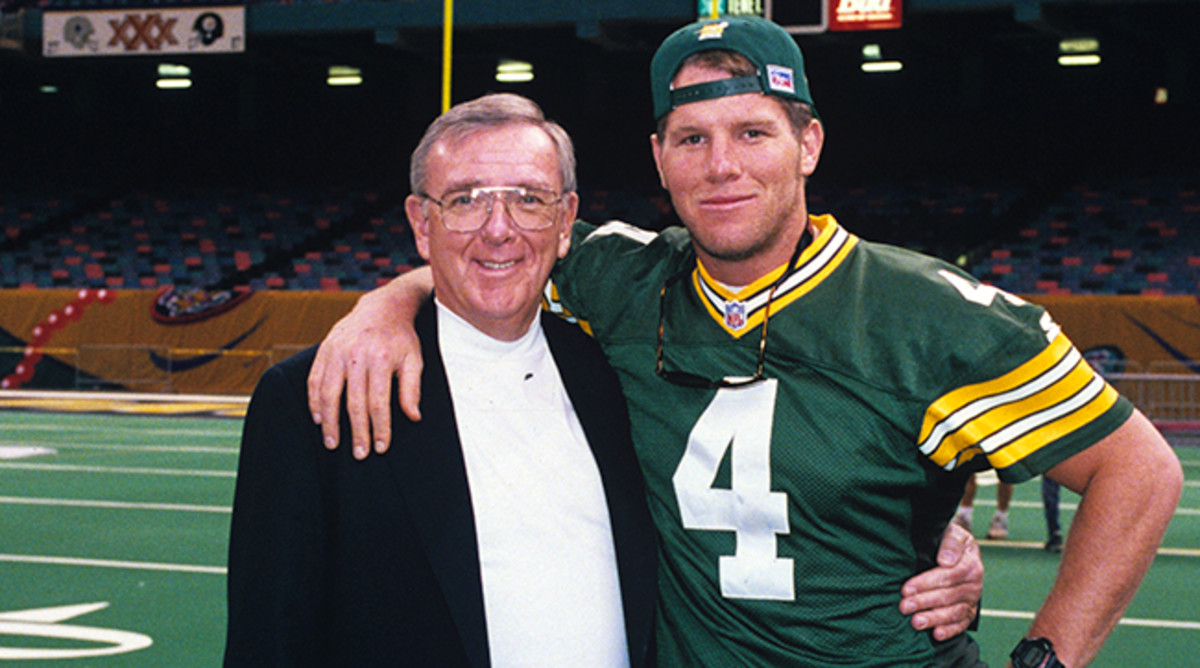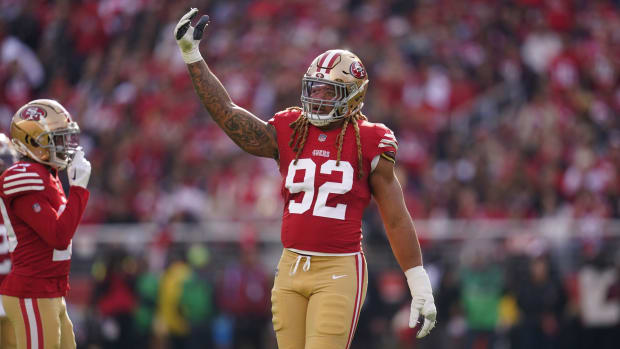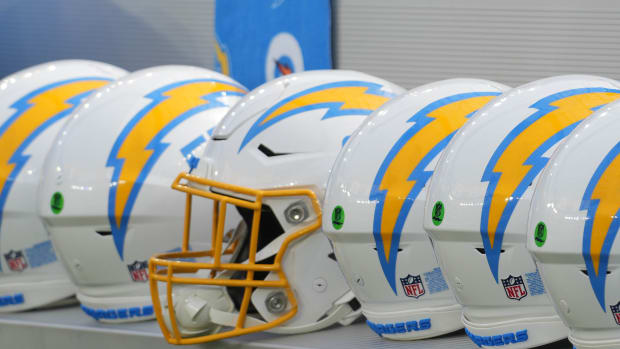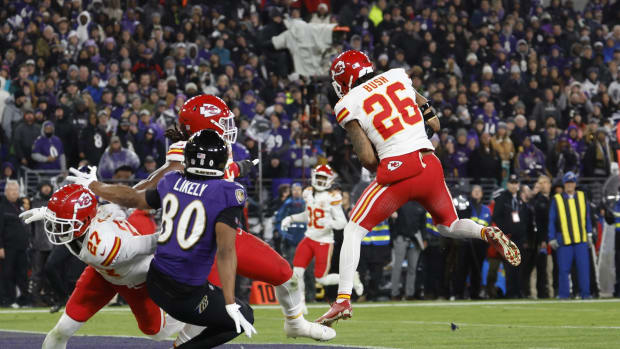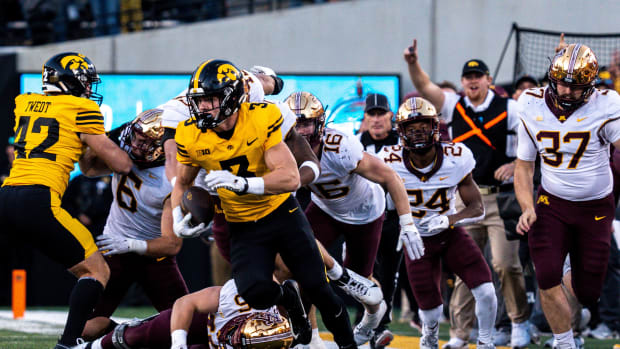The Way of the Wolf
Twenty years before becoming Kansas City Chiefs general manager, in the mid 1990s, John Dorsey was a 30-something scout with the Packers. He often found himself up late, memorizing college players’ 40 times and arm lengths. His boss, Ron Wolf, was demanding but never asked anyone to do something he wouldn’t do himself. Wolf visited colleges’ spring workouts and produced scouting reports. So when Wolf quizzed his department on a player’s numbers, he expected them to be prepared.
“He was willing to teach as much as you were willing to learn,” Dorsey says. “And you know you did well when he’d say, ‘Hey, let’s go for a drive.’ We’d drive to lunch, or just drive around, and that was a moment where it was one-on-one time outside of the office, a unique way for him to find out about us and teach us something at the same time.”
Two decades before he became Raiders GM, Reggie McKenzie was a 30-something pro personnel assistant for the Packers, a former player studying hours of film to get a better understanding of the personnel trade. Wolf often told McKenzie he had a gift. And to show faith, one day Wolf called McKenzie into his office. “He said, ‘Hey, why don’t you call this agent about an undrafted free agent,’” McKenzie recalls. “Now he didn’t ask me to go negotiate a multimillion-dollar deal, but he empowered me to make a football move for us. He then asked my opinion on a minimum-salary guy, then later on bringing in a practice squad player. Ron empowered me, and that experience was invaluable in [becoming] the executive I became today.”
In the mid 1990s, Redskins general manager Scot McCloughan and Seahawks GM John Schneider were 20-something scouts with Green Bay while current Packers general manager Ted Thompson was director of player personnel.
“For many of us, we only know one way of doing it, the Ron Wolf way,” Dorsey says. “Many decisions we make here [with the Chiefs] are rooted in what I learned in Green Bay.”
As The MMQB embarks on Green Bay Week—delving into the culture and tradition of one of America’s most cherished (and secluded) NFL cities—we would be remiss not to write about the father of the modern Packers model. In 1991, Wolf inherited a franchise stuck in the mire. From 1992 to 2002 he engineered a robust turnaround, including seven consecutive winning seasons, six straight playoff appearances and a Super Bowl. Wolf is often lauded for three transformative personnel moves: hiring Mike Holmgren as coach, trading for quarterback Brett Favre and signing defensive end Reggie White, coinciding with the birth of free agency.
But equally pertinent are Wolf’s scouting philosophies and draft success. Five current general managers, all with potentially playoff-bound teams (Dorsey, McCloughan, McKenzie, Schneider and Thompson), were groomed under Wolf. And the lessons Wolf preached to his pupils two decades ago are as relevant as ever.
* * *
Wolf’s most notable stamp on modern scouting is his view on quarterbacks: While there’s only room for one starter, you can never acquire too many. In Wolf’s world, it is worthwhile to draft a QB every year, no matter the current roster situation. “Looking now from afar, the best quarterback in the game is a sixth-round draft choice [Tom Brady], and that should alert everybody,” Wolf says. “Then you look at what the Cowboys have accomplished with a fourth-round draft choice. I mean, it tells you what you should do. Those who do not know history are doomed to repeat it.”
Consider that in seven out of eight drafts from 1992 to ’99, Wolf drafted a quarterback, even after Brett Favre was entrenched as the starter. “I learned very early in this game, if you don’t have a quarterback, you don’t have a chance,” Wolf said. “We were very lucky that we had a unique quarterback that never missed a game. But that didn’t stop me from drafting in late rounds. It’s the premiere position, and you better be able to cover yourself.”
In acquiring extra arms—among them Ty Detmer (1992 ninth round), Mark Brunell (’93 fifth round), Matt Hasselbeck (’98 sixth round) and Aaron Brooks (’99 fourth round), all of whom became starters for other teams—Wolf says he was bringing in players to challenge Favre. But more importantly, he was looking for raw talent to cultivate for backup roles, or to dangle for a trade and acquire even more draft picks.
“As long as you have the good coaches willing to take the time to develop, that model can work,” says Dorsey, who has taken QBs in two of his four drafts with the Chiefs.
“You’re not picking a quarterback every year just to stockpile them,” says McKenzie, who drafted Connor Cook in last year’s fourth round even with budding 25-year-old star Derek Carr and 26-year-old backup Matt McGloin already under contract. “But I have to say Ron Wolf's philosophy was most ingrained in me, in the process of picking Conor Cook. Even though we have a starter, and a backup for another year or two, that’s beside the point. If you have a guy ranked high in the draft, and he somehow falls to you, you don’t say, ‘Well, I need a receiver, so I'm going to take a guy that's much lesser ranked [on our draft board] than a quarterback.’ You take the quarterback, especially in the late round, over a need position and hope he gives you some value.
“That’s how important the position is. Ron always taught us to not see what’s right in front of you, but look down the road. That’s what we did with Aaron Brooks and Matt Hasselbeck, and what I did with Connor Cook.”
In evaluating the 2017 draft class, this strategy could be prominent. There are no surefire franchise quarterbacks, or even surefire first-round picks, as teams could be reaching for Deshaun Watson or Mitch Trubisky, DeShone Kizer or Brad Kaaya should any of the underclassmen declare early. However, there is a plethora of intriguing talent deeper in the pool, including Davis Webb of California, Pat Mahomes of Texas Tech, Nate Peterman of Pittsburgh, Taysom Hill of BYU, Mason Rudolph of Oklahoma State and Seth Russell of Baylor.
Which, naturally, brings up this question: How does a team determine who is worth taking a flier on?
“It’s blind luck,” Wolf said. “If I knew how to put together a quarterback, I’d have my own island somewhere.
“People would come to me, show me tape, and we’d discuss this and that. There’s just no question it has always been a difficult position to evaluate. When I was growing up, when the Colts came back to pro football in 1953, there were 12 teams in the league. I’d say seven had quarterbacks, and five didn’t. Now if you look at the 32 teams, maybe half have quarterbacks, and half don’t. Sometimes you don’t know what a guy has in college until you bring him in. Take Hasselbeck—we always thought he had a good arm and he was smart, but once he was in our building we realized we had someone a heck of a lot better than a sixth-round draft choice.”
* * *

A largely home-grown roster brought the Lombardi Trophy back to Green Bay in Super Bowl XXI.
Jim Biever/AP
Wolf’s other lasting legacy is an insistence on a home-grown roster. Even as he ushered in the free agency era with the seismic Reggie White addition, the Packers famously build their roster through the draft. This has been emphasized under Thompson.
Currently, despite a roster ravaged by injuries, only five players on Green Bay’s two-deep ever appeared in a game with another team (OLB Julius Peppers, DL Letroy Guion, TE Jared Cook, P Jacob Schum and recently signed RB Christine Michael). Last year Press Gazette Media crunched the numbers to find that between 2005 and ’15, Thompson drafted 104 players, and Green Bay led the NFL with 1,860 starts and 3,267 games played from players it had drafted—119 more starts and 106 more games played by such players than any other NFL team. “We discovered early on that it was better to keep your own than get somebody else’s,” Wolf says. “You know truly what you have when you’re playing your own.”
Explains The MMQB’s Andrew Brandt, who spent nine years as vice president of the Packers: “It works because coaches have to be able to trust and play younger players. The theory Ron used was, if you get a veteran as a backup, then you’re stunting the growth of one of your potential future assets.” Consider that after last year’s wild-card loss, Washington’s McCloughan bucked the Dan Snyder-era trend of spending big in free agency. McCloughan made no significant moves until April, when All-Pro corner Josh Norman unexpectedly sprouted on the market. “The reason I waited,” McCloughan told me in an interview last spring, “is because I was taught by Ron Wolf. And if you’re taught by Ron Wolf, you understand the importance of patience.”
• BUCKET LIST—GREEN BAY: The MMQB is spending a game week in Titletown for a deep dive into the NFL’s most tightly knit football community. Check out the content on our site, as well as Twitter, Facebook and Instagram.
Of course, Wolf wasn’t totally frugal. Among his mantras was, Identify what needs to be fixed, then go fix it. And he understood there was a time for everything. “You want to do what Ted Thompson does, but his team was already built,” McKenzie says. “I was in the process of building mine, I got to the point where I got the contract and salary cap worked out to get some leadership in here. I already had Carr and Khalil [Mack], so I could go out and get Donald Penn and Justin Tuck that could show what leadership is like. If you don't bring in the right guys, free agency isn't going to work. That's what Ron understood—you need to do what you need to do to make it work. Even in the Super Bowl year of ’96, we claimed a guy like Andre Rison, traded for Eugene Robinson, spent a little money and got Andre Dotson as an unrestricted free agent. You don't get a whole bunch, but you’re smart about it. And then you try to stick to the draft and develop plan as much as possible.”
There’s monetary benefit to younger (and therefore cheaper) players. But there’s tremendous value in molding college players—especially significant now as NFL coaches gripe about the growing divide, stylistically, between the college and NFL games. “No question,” Dorsey says, “if you can keep a player in your system, with your coaches, it makes you better off.”
“The whole time I was there we never lost a player [to free agency] we really wanted [to keep], that was really important to me,” Wolf says. “Except for one, because it became a bigger money issue.”
That player? Craig Hentrich, a punter.
“The framework of the game changed dramatically since when I was there, just starting in free agency, and now there are so many avenues open to acquiring players,” Wolf says. “But scouting? In scouting, really nothing has changed.
“Either players can play or they can’t. Either you can evaluate or you can’t. I’d say the access has changed in terms of being able to gather more tape, see film of college players from more angles, but the true principles have remained the same.”
* * *
PICK MY GUY
A current NFL player explains why his former collegiate teammate is destined for success as a pro. Here’s 49ers offensive lineman Joshua Garnett hyping former Stanford teammate Christian McCaffrey.
“He’s a freak athlete. He’s the best athlete I’ve ever seen. But regardless of that, the pro abilities he displays in college are something that take guys in the league years to develop. The vision he has, the way he’s able to set up blocks; he’s an elite player that does stuff NFL running backs do, and in the college game. A lot of times that’s unheard of. He was able to set up linebackers for us. When you think of Christian McCaffrey, you think of the dazzling runs and finesse stuff, but when a linebacker comes, he’s going to pop him. He’s going to stick his head in there and hit. In the Rose Bowl against Iowa, we ran an outside zone play to the left, and a linebacker came and I just literally put a fingertip on the guy, there was no way I was going to get him. But Christian set him up so well, bounced outside and ran for like 80 yards. A lot of running backs would have tried to hit downhill there, but for him to set it up like that, it’s just ridiculous. Unfortunately that play ended up being called back, but it just shows some of the stuff Christian can do. Being able to block for him was one of the highlights of my football career.”
* * *
THE ANONYMOUS SCOUT
A few NFL evaluators introduce you to the players they’re keeping an eye on…
Obi Melifonwu, DB, Connecticut: Freak athlete. Hard-hitter. Very strong in run support and a sound open-field tackler. Bright kid, too.
Taywan Taylor, WR, Western Kentucky: He’s not tall, but I can see him playing both in the slot or outside. Big yard-after-catch opportunities with him. Home run-threat type of guy.
Ethan Pocic, OL, LSU: I like him. He’s tall [Pocic is listed by school at 6'7"] but athletic. Strong in pass protection and hits blocks at second level. A consistent guy.
* * *
COLLEGE COLUMN ALUMNI UPDATE
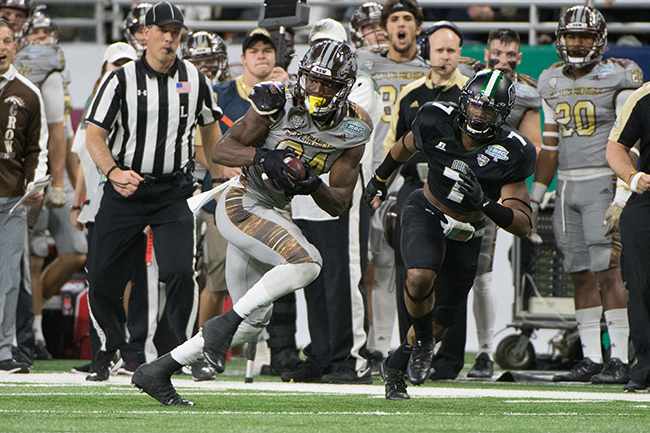
After leading Western Michigan to an undefeated regular season, Davis could be ticketed for Round 1.
Steven King/Icon Sportswire
With the NCAA regular season finished, let’s check in on a few players I wrote about this season—call them College Column alumni—and see how they’re faring…
Brady Gustafson, QB, Montana: I attended Gustafson’s game against Northern Iowa in September, in my search for “The Next Carson Wentz.” I was intrigued by the FCS product’s potential—6'7", naturally gifted arm—but concluded: “Is Brady Gustafson the next Carson Wentz? Probably not. But because of Wentz, a prospect like Gustafson is going to get a long look.” I’ll chalk that up as prescient. Scouts trailed Gustafson all season, which was at times tumultuous. He missed two games with an injury, and in one of those contests, backup Chad Chalice threw for a school-record seven touchdowns, and ran for another, leading evaluators to wonder if Gustafson’s production was simply a byproduct of Coach Bob Stitt’s high-octane offense. “[Gustafson] has the tools,” one scout told me. “But at this point, he’s too much of a project.” Still, Gustafson threw for 2,785 yards, 309.4 per game, with 26 touchdowns and eight interceptions. Instead of waiting for a possible invite to the Senior Bowl, the premiere end-of-season all-star game, Gustafson accepted his bid to the NFLPA Collegiate Bowl.
My draft prediction: Possible sixth- or seventh-round flier, but most likely undrafted free agent.
Corey Davis, WR, Western Michigan: The precocious wideout always displayed tremendous potential, and yet managed to exceed expectations as a senior. In a way he mirrors the success of his school, a MAC darling that soared to an undefeated season and Cotton Bowl berth behind energetic coach P.J. Fleck. Davis averaged 15.7 yards per catch in 2016, and his 18 TDs are best among all FBS receivers. He’s also now the all time FBS leader in career receiving yards, with 5,213 (and could add more). He came up in the clutch when the Broncos needed him, like the MAC Championship game, when he made four catches for 105 yards, including a 70-yard scoring play that helped fend off a pesky Ohio team. Scouts visiting Kalamazoo have heard nothing but good things about Davis, who is studious and unassuming off the field.
My draft prediction: Late first round, early second round.
Chad Kelly, QB, Ole Miss: Kelly suffered a rough month after I visited Oxford in mid-October. The Rebels dropped three straight games to SEC foes, then in November Kelly underwent a draft prospect’s nightmare: season-ending surgery on a torn ACL and a torn lateral meniscus. The nephew of Hall of Famer Jim Kelly was always supremely talented but sometimes displayed inconsistent tendencies aligning with his gunslinger mentality. Off the field Kelly has a checkered past. Even so, he was unequivocally the top senior quarterback in an otherwise weak field. He finished his 22-game Ole Miss career with 6,800 passing yards, 832 rushing yards and 65 total touchdowns. He accepted a bid to the Senior Bowl, offered to him pre-injury and, according to a source, said he will still make the trip to Mobile. Though it seems unlikely Kelly will be cleared to play for the January 28 game, he can participate for his day of team interviews (there is precedent for this; Aaron Murray of Georgia had a similar arrangement in 2014). In my opinion that’s a smart move for Kelly. Teams believe they can tweak his footwork and mold Kelly’s decision-making when it comes to risky downfield throws. If he performs well in interviews, he can only improve his stock.
My draft prediction: Day three pick.
Question or comment? Email us at talkback@themmqb.com.
































